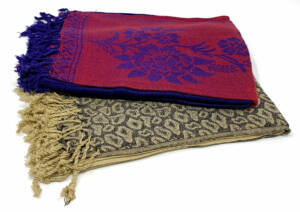Project Report For Shawls, Stoles, Scarves & Wraps
Introduction
Project report for shawls, stoles, scarves & wraps is as follows.
Shawls were typically worn in the winter and were made of wool. It has developed into a fashionable item that is worn all year long to ward off cool weather, cover shoulders, or improve the appearance of top garments. These days, shawls come in a range of fabrics and are lighter in weight. Although they have a similar appearance to shawls, stoles are shorter and slimmer.
In comparison to shawls, stoles also have simpler patterns and weaves. Scarves are made of a thin, light cloth that covers usually the neck and occasionally a portion of the upper body. Despite the fact that scarves are often small, there is no size restriction; they can be as large as shawls. Larger scarves, however, are constructed of lighter fabric. Rectangular pieces of fabric called wraps are used to cover the upper half of the body in various ways. Therefore, shawls, stoles, scarves, and wraps act as more of an accessory than a clothing and can be used for fashion, function, or decoration.

Product & Uses of Shawls, Stoles, Scarves & Wraps
Women are more likely to use these products. Elderly men may also use shawls and scarves to keep warm in cold weather. The shawl comes in a rectangular shape, though you can occasionally get it in a square shape as well. It is slightly larger than the scarf.
The shawl can be used to conveniently cover the upper half of the body, therefore its purpose is not limited to wrapping around the neck. The shawl’s dimensions are typically in the range of 100*200 cm. One of the most well-liked accessories that is frequently employed in the fashion industry is the scarf.
Hollywood stars are frequently spotted wearing scarves combined with coats or jackets. Without the usage of a scarf, winter clothing is practically incomplete. It makes sense that our large snowman, who you can hardly image without a red scarf, is also a great scarf admirer.
Project Report Sample Of Shawls, Stoles, Scarves, & Wraps
Get Completely Custom Bankable Project Report
Row Material
These items are made from a variety of fabrics. Additional fabric work includes embroidery or hand-work of various fibres, glass work, pipings, patches, cords, danglers, buttons, rings, and so on in a variety of colours, shapes, and sizes. Tailoring material stores throughout India sell accessories. Fabrics of various blends are also easily available from fabric traders and mills.
Manufacturing Process Shawls, Stoles, Scarves & Wraps
The cloth is spread out in layers on the cutting table after being acquired in roll form. Patterns of various sections of the items made of cardboard, plywood, or metal are set on the fabric in such a way that fabric waste is minimized. Several layers of fabric are then sliced using a vertical motorized blade.
Products are stitched in an assembly line fashion, with each machine operator completing only a portion of the product. Stitching begins on the first machine and continues until the product is evaluated for quality flaws, if any. Some items are sent out for further work such as embroidery, custom patchwork, piping, glasswork, and so on.
Market Potential Of Shawls, Stoles, Scarves & Wraps
The global winter wear market was worth USD 268.3 billion in 2018 and is expected to grow at a compound annual growth rate (CAGR) of 4.3% between 2019 and 2025.
Expenses

Product Cost Breakup

Reveneue Vs Expenses

Market Trend

Temperatures below zero in many areas are increasing demand for winter clothing to protect the body from frostbite. Furthermore, several thin layers of clothing can be more effective at keeping you warm than a single large, bulky layer, increasing the volume of winter clothing sales. Changing fashion trends, as well as frequent travel by many people to cooler places for vacation and work purposes, will also drive the global market during the forecast period.
Consumer demand for winter wear products increases as global warming conditions worsen, lowering weather temperatures across the globe. However, the expansion of distribution channels in the apparel sector has shaped the product’s demand. The market is driven by the rise in consumer purchasing power, as well as demand for premium and branded products among various end-users.
However, sudden changes in weather, combined with deteriorating environmental conditions, have increased sales of winter wear clothing in a variety of industries. Furthermore, a shift in consumer preferences from traditional to newly introduced apparel, as well as an attraction to light-weighted winter wear products, has fueled its growth over the forecast period.

